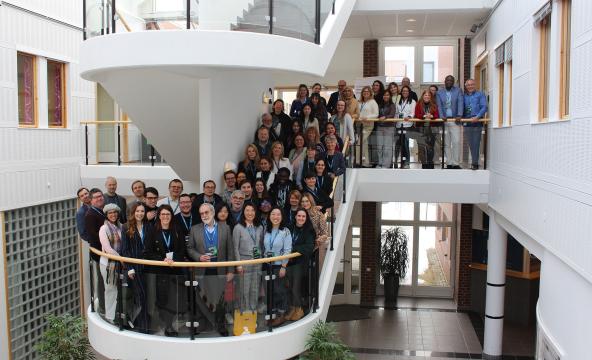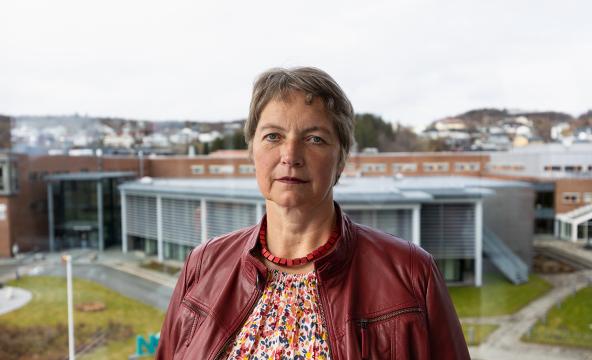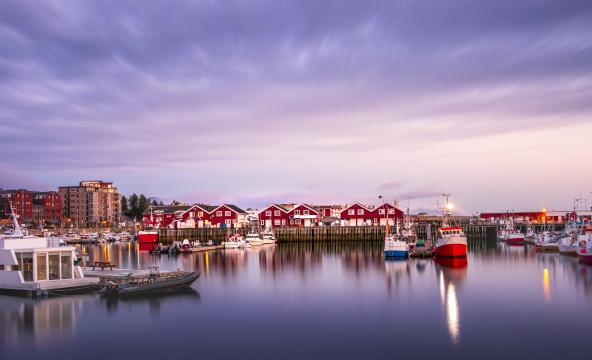
Calanus: The King of the Norwegian Sea, or a relative? Copepods of the genus Calanus constitute the main diet for fish larvae of a variety of important fish species along the Norwegian coast. At the same time, they are nearly impossible to identify to species without the use of advanced methods. Photo: Mads Schultz
The small copepod Calanus, in Norway better known as raudåte, plays a key role in the ocean up here in the north. This tiny zooplankton feeds on phytoplankton and is, in turn, eaten by fish and other organisms higher up in the food chain. Young stages, known as copepodites, are considered the most important food resource for fish larvae along the coast.
At times, 90 percent of all zooplankton along the Norwegian coast consists of Calanus. Until now, it has been assumed that the dominant species has been C. finmarchicus, but according to researchers at Nord University, this needs to be reconsidered.
Thousands upon thousands of copepods analysed
"At first, no one believed me", says researcher Marvin Choquet.
He had just started his doctoral studies at Nord University and was working with water samples from Skjerstadfjorden, when he by chance discovered that there was a different Calanus species in the samples than expected.
"Skjerstadfjorden is actually very well studied by researchers. And everyone knew that in Skjerstadfjorden, it is C. finmarchicus that reigns, the king of the Norwegian Sea!"
However, the new genetic tools Choquet worked with showed that there were several different Calanus species in the fjord.
"Everyone thought I was just a novice student who had made a mistake in the lab. So, I conducted more tests and found out that there was actually more of the species C. glacialis. It has always been considered an Arctic species, which had nothing to do inside Skjerstadfjorden."
Now it was no more of not being believed. By conducting more tests, the researchers in Bodø found that there were four species of Calanus in the fjord, not just one. Through the work of doctoral student Mads Schultz, they found that all four species reproduced in the fjord. This began a meticulous work of analysing zooplankton samples from the entire North Atlantic and the Arctic Ocean.
"I analysed thousands upon thousands of copepods and realised that we have been wrong on so many levels! Not just inside the fjords, but also in the ocean. Supposedly Arctic species of Calanus were found as far south as the Oslofjord, while more temperate species of the North Sea was found as far north as Tromsø. This made it possible to describe the distribution of the four Calanus species in the northern hemisphere completely anew", says Choquet.

Large in the north, smaller in the south
The common way to determine the different species has been to look at body size, as well as the color of certain body parts. Better trained taxonomists will even dissect certain legs of the Calanus.
"The view used to be that the two Arctic species were larger, and the North Atlantic ones smaller. But it turns out that it varies with where they are located. When C. glacialis stays in warmer water, they are smaller in size. The pigmentation seems to vary as well, depending on location. It is not species-specific. So, in practice, it's not possible to see the difference between them", says Choquet.
To be sure, the researchers in Bodø sent samples to two internationally recognized experts on species determination of Calanus. Would they manage to correctly identify the individuals to the right species? The two experts were not allowed to collaborate on the job. In advance, the researchers in Bodø had determined the species of the individuals using a genetic method that they developed making use of the DNA from one antenna only.
"Both experts placed around 30 percent of the individuals in the wrong species. The peculiar thing was that the misidentification did not concern the same individuals", Choquet explains.
He believes this shows that one cannot rely on visual methods for species determination of red copepods.
"One must use genetic methods to be sure of which species one is dealing with".
Atlantic waters and atlantic species
One might ask if it really matters if one has been mistaken about the species within a genus of copepods. They are all quite similar, does it make a difference?
"It has great significance. The different species are used as indicators for different water masses in climate models. In addition, different species may play different roles for the ecosystems, have different life cycles and respond differently to climate change impacts, says professor Galice Hoarau at North University".
The Arctic is now the region that is experiencing climate change the most. Here, the ocean is warming up four times faster than other ocean areas. This leads to "atlantification" - warm Atlantic water flowing northward and changing the living conditions for plants and animals in the far north. C. finmarchicus thrives best in Atlantic water, while C. glacialis is considered typical of the Arctic. Two other species – C. helgolandicus and C. hyperboreus – are used as indicators for more temperate and more central Arctic water masses, respectively.
"Each of the species represents a specific environment, although we found multiple areas of overlap, showing a certain degree of flexibility When the environment changes, one species may disappear and be replaced by another that prefers the new environment. To be able to monitor this, we need to be able to distinguish between the species", says Choquet.

Seabirds with the belly full of – what?
In Svalbard, the seabird little auk primarily feeds on red copepods, where the fat found in C. glacialis and C. hyperboreus constitutes a vital energy source for the birds. The little oak plays an important role in Svalbard's ecosystem, where they "fertilize" land areas with nutrients from the ocean in the form of feces.
"These birds are specialised on Calanus. Researchers have used the diet of the little auk to monitor the pace of “atlantification” of the Arctic and climate change in Svalbard, where it has been thought that the diet has contained more and more C. finmarchicus. But when we use genetic methods, we see that it still almost exclusively eats C. glacialis, just that they have become much smaller in size.
With increased "atlantification" of Arctic water masses, researchers expect the two species to increasingly live side by side. There is also fear that C. finmarchicus will take over the place of C. glacialis, and that this will have hitherto unknown consequences for ecosystems.
"Our findings show that we need to enforce the systematic use of genetics in studies involving Calanus, if we want to keep using them as beacons of climate change", Choquet says.
Important research
One who has dedicated a long life in science to studying the red copepod is Professor Emeritus Stig Skreslet. He says the genetic studies turn upside down previous perceptions of the distribution of Calanus in northern sea areas.
"The ecology of the oceans has been in strong change over the last decades, and it continues. Global warming has changed ice conditions, ocean currents, and the water budget throughout the Arctic Mediterranean, which includes all seas located between the North American and the Eurasian continent", says Skreslet.
These changes affect the production of fish and other biological resources in large sea areas and thus the national economy.
"We still know little about both generational development and local conditions in the fjords and how this is related to the large population systems. Therefore, marine ecology as a field of study faces major challenges that Nord University is in an excellent position to address. We are well-equipped to contribute to the solution of large and important scientific tasks that the world needs and Norway must be willing to finance", says Skreslet.

Read more:
- Mads Schultz et al 2023: Calanus helgolandicus - more than a guest in the north? https://academic.oup.com/plankt/article/45/1/33/6887242
- Marvin Choquet et al 2018: Can morphology reliably distinguish between the copepods Calanus finmarchicus and C. glacialis, or is DNA the only way? https://aslopubs.onlinelibrary.wiley.com/doi/10.1002/lom3.10240
- Marvin Choquet et al 2017: Genetics redraws pelagic biogeography of Calanus https://royalsocietypublishing.org/doi/10.1098/rsbl.2017.0588







